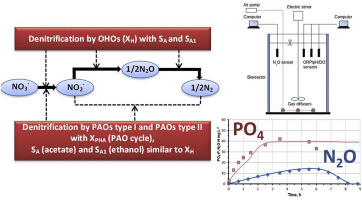Water Research ( IF 12.8 ) Pub Date : 2018-05-24 , DOI: 10.1016/j.watres.2018.05.041 K. Wisniewski , M. Kowalski , J. Makinia

|
In this study, the IWA Activated Sludge Model No. 2d (ASM2d) was expanded to identify the most important mechanisms leading to the anoxic nitrous oxide (N2O) production in the combined nitrogen (N) and phosphorus (P) removal activated sludge systems. The new model adopted a three-stage denitrification concept and was evaluated against the measured data from one/two-phase batch experiments carried out with activated sludge withdrawn from a local, large-scale biological nutrient removal wastewater treatment plant. The experiments were focused on investigating the effects of different external carbon sources (acetate, ethanol) and electron acceptors (nitrite, nitrate) on the mechanisms of N2O production in enhanced biological P removal by polyphosphate accumulating organisms (PAOs) and external carbon-based denitrification by ordinary heterotrophic organisms (OHOs). The experimental results explicitly showed that N2O production was predominantly governed by the presence of nitrite in the reactor regardless of the examined carbon source and the ratio COD/N in the reactor. The model was capable of accurately predicting (with R2 > 0.9) the behavior of not only N2O-N, but also NO3-N, NO2-N, soluble COD, and PO4-P. The simulation results revealed that only OHOs were responsible for N2O production, whereas the present denitrifying PAOs reduced only nitrate to nitrite.
中文翻译:

在存在不同碳源和电子受体的情况下,通过反硝化增强生物除磷(EBPR)活性污泥模拟一氧化二氮的产生
在这项研究中,扩展了IWA 2d型活性污泥(ASM2d),以识别导致去除氮(N)和磷(P)的混合活性污泥中产生缺氧一氧化二氮(N 2 O)的最重要机制。系统。新模型采用了三阶段反硝化概念,并根据从本地大型生物营养去除废水处理厂抽取的活性污泥进行的一阶段/两阶段分批实验的测量数据进行了评估。实验着重于研究不同外部碳源(乙酸盐,乙醇)和电子受体(亚硝酸盐,硝酸盐)对N 2机理的影响。通过多磷酸盐累积生物(PAO)以及通过普通异养生物(OHO)进行的基于碳的外部反硝化作用,提高了O的产生。实验结果明确表明,无论所检查的碳源和反应器中COD / N之比如何,反应器中亚硝酸盐的存在主要决定着N 2 O的产生。该模型不仅能够准确预测(R 2 > 0.9)N 2 O-N的行为,而且还能准确预测NO 3 -N,NO 2 -N,可溶性COD和PO 4 -P的行为。模拟结果表明,只有OHO负责N 2O的产生,而目前的反硝化PAO仅将硝酸盐还原为亚硝酸盐。



























 京公网安备 11010802027423号
京公网安备 11010802027423号